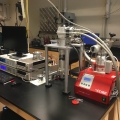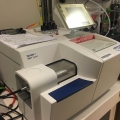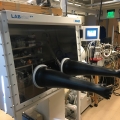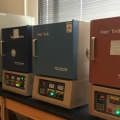Electronic transport properties of two samples can be studied simultaneously between 4 - 300 K. Supporting electronics allow for both AC and DC measurements. Future functionality will include zero-field heat capacity.
Facilities
Our group’s lab space is located in the Engineering Science Building. Key equipment centers around material synthesis as well as preliminary characterization of chemical and electrical properties.
Equipment
Thermogravimetric analysis and differential thermal analysis calorimetry techniques are used to characterize the rate and nature of chemical reactions of samples at high temperatures. Careful study of the output heat flow curves can provide insight into a compound's chemical phase transitions.
Pressures near 50 kPSI are achieved with an fluid pressure medium to press loose powders into denser pellets or rods for further reactions or characterization.
Provides an inert environment (Ar gas) to store and handle volatile or toxic compounds as well as those with air/moisture sensitivity. Catalysts actively clean the environment, maintaining H2O and O2 levels below 0.5 ppm.
A stable of furnaces permit multiple parallel synthesis projects, with stable temperatures of up to 1600° C. Programmable controllers allow for custom heating profiles to tune compound growth parameters. Select configurations permit reactions under atmospheres of flowing gas (nitrogen, argon, etc.).






